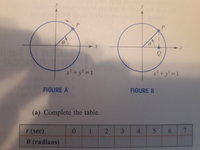harpazo
Full Member
- Joined
- Jan 31, 2013
- Messages
- 891
Use the picture below to answer parts A-D.
Suppose that the point P travels counterclockwise around the unit circle at a constant angular speed of pi/3 radians per second. Assume that at time t = 0 sec, the location of P is (1, 0).
A. Complete the table. I am confused concerning the location of t in the picture.
B. Draw a sketch showing the location points P and Q when t = 1 second. I need the set up for part B.
C. If you look back at the table in part A, you'll see that the relation between theta and t is theta = (pi•t)/3. Thus, the x-coordinate of Q at time t is given by x = cos (pi/3). This tells us that as the point P moves around the circle at a constant angular speed, the point Q oscillates in simple harmonic motion along the x-axis. Graph the function for two complete cycles, beginning at t = 0. Specify the amplitude, the period and the frequency for the motion.
D. Using calculus, it can be shown that the velocity of the point Q at time t is given by
v = (-pi/3)•sin(pi•t/3). Graph this function for two complete cycles, beginning at t = 0.
Note: I want to do the math work here. Looking for the set up and SET UP ONLY for parts A through D. I will do the rest. Thank you. Happy Sunday to all of you!

Suppose that the point P travels counterclockwise around the unit circle at a constant angular speed of pi/3 radians per second. Assume that at time t = 0 sec, the location of P is (1, 0).
A. Complete the table. I am confused concerning the location of t in the picture.
B. Draw a sketch showing the location points P and Q when t = 1 second. I need the set up for part B.
C. If you look back at the table in part A, you'll see that the relation between theta and t is theta = (pi•t)/3. Thus, the x-coordinate of Q at time t is given by x = cos (pi/3). This tells us that as the point P moves around the circle at a constant angular speed, the point Q oscillates in simple harmonic motion along the x-axis. Graph the function for two complete cycles, beginning at t = 0. Specify the amplitude, the period and the frequency for the motion.
D. Using calculus, it can be shown that the velocity of the point Q at time t is given by
v = (-pi/3)•sin(pi•t/3). Graph this function for two complete cycles, beginning at t = 0.
Note: I want to do the math work here. Looking for the set up and SET UP ONLY for parts A through D. I will do the rest. Thank you. Happy Sunday to all of you!


